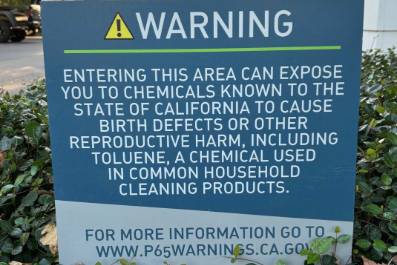Where can information regarding specific chemical safety be found? If you’re handling chemicals at work or home, knowing exactly where to find reliable safety information is crucial for protecting yourself, your family, and your coworkers.
You don’t have to guess or rely on unclear labels. In this guide, you’ll discover trusted sources like Safety Data Sheets (SDS), chemical labels, and official regulatory websites that provide clear, detailed safety information. By the end, you’ll feel confident finding the right chemical safety data and staying protected every time you handle hazardous materials.
Keep reading—your safety depends on it.

Credit: www.youtube.com
Government Agencies
Government agencies provide reliable information on chemical safety. They set rules and share data to protect people and the environment. These agencies offer clear guidelines and resources. Their information helps workers, businesses, and the public stay safe around chemicals.
Osha Guidelines
The Occupational Safety and Health Administration (OSHA) creates safety rules for workplaces. OSHA’s guidelines cover handling, storing, and using chemicals safely. They offer Safety Data Sheets (SDS) standards. These sheets explain chemical hazards, protective measures, and emergency steps.
OSHA also sets exposure limits to protect workers’ health. Their website includes training materials and compliance assistance. Employers use OSHA guidelines to reduce accidents and illnesses.
Epa Databases
The Environmental Protection Agency (EPA) collects data on chemical effects on health and nature. EPA databases provide toxicity info, pollution limits, and safe disposal methods. They track chemical use and releases into air, water, and soil.
EPA’s Substance Registry Services and Toxics Release Inventory are key tools. These help identify chemical hazards and monitor risks. The EPA supports policies to reduce harmful chemical impacts.
Nih Resources
The National Institutes of Health (NIH) offers scientific research on chemical safety. Their National Library of Medicine hosts databases like TOXNET. These contain detailed chemical toxicity and health effect studies.
NIH resources support medical and environmental safety decisions. They provide clear, evidence-based info for researchers and the public. Their work helps improve understanding of chemical dangers and treatments.

Credit: cen.acs.org
Industry Standards
Industry standards serve as the backbone for chemical safety information. They provide clear, reliable guidelines that help you handle chemicals safely and legally. Without these standards, navigating the complex world of chemical hazards would be confusing and risky.
Chemical Safety Data Sheets
Chemical Safety Data Sheets (SDS) are essential documents that offer detailed information about each chemical’s properties and hazards. You’ll find instructions on safe handling, storage, and emergency measures. If you ever feel unsure about a chemical, the SDS is your first and most trustworthy resource.
Think about the last time you worked with a new chemical. Did you check the SDS before starting? It’s easy to overlook, but that simple step can prevent accidents and protect your health.
Iso Standards
ISO standards provide internationally recognized guidelines for chemical safety management. These standards ensure consistency and quality across industries worldwide. If your work involves chemicals, following ISO standards helps you meet legal requirements and improve safety practices.
Have you ever wondered how companies maintain safety across different countries? ISO standards make it possible by creating a common language for chemical safety.
Nfpa Codes
The National Fire Protection Association (NFPA) codes offer a color-coded system to quickly identify chemical hazards. This simple visual guide helps you assess risks at a glance, especially in emergencies. Knowing NFPA codes can save precious time when responding to chemical spills or fires.
Imagine a scenario where every second counts. Would you feel confident identifying chemical hazards quickly? Learning NFPA codes equips you with that confidence.
Online Databases
Online databases are a reliable source for chemical safety information. They offer detailed data on chemical properties, risks, and handling guidelines. These platforms are accessible, user-friendly, and regularly updated. By using them, you can stay informed about specific chemical hazards and safety measures.
Pubchem
PubChem is a free resource from the National Institutes of Health. It contains extensive information on chemical substances, including safety data. You can search by chemical name, structure, or CAS number. PubChem also provides links to related studies and regulatory details.
Chemspider
ChemSpider is a chemical database developed by the Royal Society of Chemistry. It offers detailed data on over 100 million chemical compounds. You can find safety information, molecular structures, and more. ChemSpider integrates data from multiple sources, ensuring accuracy.
Toxnet
TOXNET is a collection of databases focused on toxicology and hazardous substances. It provides information on chemical toxicity, environmental effects, and safety precautions. TOXNET is especially useful for professionals working with hazardous materials.
Academic And Research Institutions
Academic and research institutions play a crucial role in providing reliable information about chemical safety. Whether you’re a student, researcher, or safety officer, these organizations are often a treasure trove of resources. They are dedicated to ensuring safe practices in laboratories and fostering a culture of safety awareness.
University Safety Protocols
Many universities have comprehensive safety protocols to guide students and staff in handling chemicals. These protocols are often outlined in easily accessible safety manuals or on the university’s website. They cover essential topics like proper storage, disposal methods, and emergency procedures.
Check your university’s Environmental Health and Safety (EHS) department. They typically offer training sessions and maintain up-to-date guidelines tailored to the chemicals used in their facilities. You might even find interactive tools or videos to simplify the learning process.
Research Publications
Research papers often include detailed safety measures for specific chemicals. Journals like the Journal of Chemical Health and Safety or Chemical Research in Toxicology are excellent sources. These publications provide insights into real-world experiments and the precautions taken during studies.
Digging into these papers can also reveal innovative safety practices. Researchers frequently share what worked and what didn’t, saving you from repeating mistakes. If you’re conducting experiments, this kind of targeted information can be a game-changer.
Specialized Safety Centers
Many academic institutions host specialized safety centers dedicated to chemical safety. These centers often collaborate with national or international safety organizations. They provide in-depth resources, consultations, and even certifications to ensure best practices.
For example, the American Chemical Society (ACS) often partners with universities to offer workshops and online safety courses. Some centers even allow you to borrow safety equipment or test new safety technologies before implementing them in your lab.
Professional Organizations
Professional organizations serve as reliable sources for detailed and accurate chemical safety information. They connect you to experts, guidelines, and resources tailored to specific chemicals and safety concerns. Engaging with these groups can enhance your understanding and help you stay updated on best practices.
American Chemical Society
The American Chemical Society (ACS) offers extensive resources on chemical safety. Their publications, webinars, and safety guidelines help you handle chemicals safely in labs and workplaces.
ACS also provides access to Material Safety Data Sheets (MSDS) and safety training materials. If you want practical advice from industry professionals, ACS is a great starting point.
Society For Chemical Hazard Communication
The Society for Chemical Hazard Communication focuses specifically on sharing information about chemical hazards. It helps you understand labeling, hazard communication standards, and regulatory compliance.
By joining this society, you can access workshops and networking opportunities that directly impact how you manage chemical safety in your environment. Have you ever struggled to interpret safety labels? This group offers clear guidance.
International Chemical Safety Groups
International organizations like the World Health Organization (WHO) and the International Labour Organization (ILO) provide global standards and safety data on chemicals. Their guidelines help you compare safety practices across different countries.
These groups publish chemical safety cards and risk assessment tools that are useful whether you work in research, manufacturing, or healthcare. How does your current safety information measure up against international standards?
Manufacturer And Supplier Information
Manufacturer and supplier information is a crucial resource for anyone handling chemicals. This information provides detailed insights into the safe use, storage, and disposal of specific chemicals. Knowing where to find it can prevent accidents and ensure compliance with safety standards.
Product Labels
Product labels are your first point of contact for chemical safety information. They clearly list hazards, precautionary measures, and first aid instructions. Always check the label before using any chemical—ignoring it could lead to serious harm.
Labels often include:
- Hazard symbols and warnings
- Instructions for safe handling
- Storage guidelines
- Emergency contact information
Have you ever overlooked a label, only to realize later how important that tiny piece of information was? Don’t let that happen with chemicals—it’s a small step that can save you a lot of trouble.
Safety Data Sheets From Suppliers
Safety Data Sheets (SDS) offer comprehensive details beyond what labels provide. These documents cover chemical properties, health risks, protective measures, and emergency procedures. You can usually request an SDS directly from the supplier or find it on their website.
Here’s what you’ll find in an SDS:
- Identification and composition of the chemical
- Hazard identification and classification
- Exposure controls and personal protection
- Handling, storage, and disposal instructions
Always keep SDSs accessible in your workspace. Do you have a system for organizing and updating these sheets regularly? It could make a big difference when quick decisions are needed.
Technical Support Services
Manufacturers and suppliers often provide technical support to answer your specific safety questions. These services can clarify doubts about chemical handling, compatibility, or regulatory compliance. Don’t hesitate to reach out—they are there to help you stay safe.
Technical support might include:
- Phone or email consultations
- On-site training sessions
- Customized safety advice
Engaging with technical support can give you confidence in using chemicals correctly. When was the last time you contacted a supplier for safety advice? It might be worth trying if you’re unsure about any aspect of chemical use.
Training And Educational Materials
Accessing reliable training and educational materials is vital for chemical safety. These resources help individuals understand proper handling, storage, and disposal of chemicals. They also provide knowledge about emergency procedures and risk prevention techniques. Below are some common ways to find chemical safety training materials:
Online Safety Courses
Online courses offer flexible learning opportunities for chemical safety training. Many institutions provide detailed modules that cover hazard identification, safety protocols, and compliance standards. Learners can study at their own pace and revisit materials as needed.
Some platforms include interactive features such as quizzes and case studies. These tools enhance understanding and help learners assess their knowledge. Certificates are often provided upon completion, adding credibility to the training.
Workshops And Seminars
Workshops and seminars are excellent for hands-on learning. They allow participants to interact with experts and ask specific questions. These sessions often include demonstrations and practical activities to reinforce key concepts.
Local organizations or industry groups frequently host these events. Attending them can also provide networking opportunities. Sharing experiences with peers can deepen understanding and improve safety practices.
Instructional Videos
Instructional videos are a visual way to learn about chemical safety. They often simplify complex topics, making them easier to grasp. Videos can show step-by-step procedures for handling chemicals or responding to emergencies.
Many videos are accessible for free on educational websites or platforms. They are ideal for quick reference or supplementing other training methods. Watching them regularly can help reinforce safe practices.

Credit: www.p65warnings.ca.gov
Frequently Asked Questions
Where Can I Find Chemical Safety Information Online?
You can find chemical safety information online through government websites, industry databases, and scientific organizations. OSHA, EPA, and CDC provide reliable resources.
What Is The Best Database For Chemical Safety?
The best database for chemical safety is the NIOSH Pocket Guide. It offers detailed chemical hazard data and safety guidelines.
Are Material Safety Data Sheets (msds) Helpful For Chemical Safety?
Yes, MSDS are essential for chemical safety. They provide crucial details on hazards, handling, storage, and emergency measures for chemicals.
Can Chemical Manufacturers Provide Safety Information?
Yes, chemical manufacturers often provide safety information. They include MSDS and guidelines for proper handling and usage of their products.
Conclusion
Finding reliable chemical safety information is essential for health and safety. Trusted sources include safety data sheets, government websites, and industry guides. These resources offer clear details on handling, storage, and emergency steps. Always double-check facts from multiple places. Staying informed helps prevent accidents and protects everyone involved.
Keep safety a top priority by using the right information. Easy access to correct data makes a big difference. Stay safe, stay smart.








